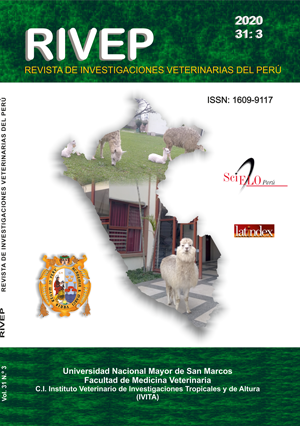Bromatological composition of vetch (Vicia sativa L) silage associated with barley (Hordeum vulgare L) and urea
DOI:
https://doi.org/10.15381/rivep.v31i3.18724Keywords:
associated, barley, vicia, ammonification, production, foragesAbstract
The present study aimed to determine the bromatological composition of the vetch silage associated with barley in five proportions and two levels of urea. A completely randomized design with three repetitions in a factorial scheme of 5 x 2 (proportions, urea) was used. The ratios of vetch and barley were: 0: 100, 25:75, 50:50, 75:25 and 100:0, respectively. Urea was added in 0 and 1% levels on a dry matter basis. Micro silos of PVC tubes 10 cm (diameter) x 60 cm (height) were used for 121 days. Samples were taken from the silos to determine dry matter (DM), crude protein (CP), neutral detergent fibre (NDF), acid detergent fibre (ADF), hemicellulose, mineral matter (MM) and pH. The vetch:barley 50:50, 75:25 and 100:0 without urea had higher DM content than the ammonified silages (p<0.05). The CP increased linearly in the silages with and without urea, especially the vetch/barley ammoniates: 25:75 and 50:50. The NDF of the ammoniated vetch/barley ratios presented a negative linear effect (52.58 to 45.30% of NDF), as did hemicellulose (21.92 to 9.51%). The FDA also decreased vetch/barley silages without and with urea with the ratio of 75:25 (35.92 to 31.23% of FDA). It is confirmed that the urea ammonification improved the nutritional value of the vetch-barley association.
Downloads
Downloads
Published
Issue
Section
License
Copyright (c) 2020 José Luis Contreras Paco, Erika Pierina Basurto Salvatierra, Alfonso Cordero Fernandez, Hugo Raúl Ramírez Rivera, Rufino Paucar Chanca, Michael Esteban Paytan, Kelly Huaman Soto

This work is licensed under a Creative Commons Attribution-NonCommercial-ShareAlike 4.0 International License.
AUTHORS RETAIN THEIR RIGHTS:
a. Authors retain their trade mark rights and patent, and also on any process or procedure described in the article.
b. Authors retain their right to share, copy, distribute, perform and publicly communicate their article (eg, to place their article in an institutional repository or publish it in a book), with an acknowledgment of its initial publication in the Revista de Investigaciones Veterinarias del Perú (RIVEP).
c. Authors retain theirs right to make a subsequent publication of their work, to use the article or any part thereof (eg a compilation of his papers, lecture notes, thesis, or a book), always indicating the source of publication (the originator of the work, journal, volume, number and date).










